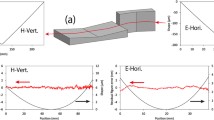Abstract
We have developed a prototype spectroscopic ellipsometer for imaging/mapping purposes requiring only one measurement cycle (one rotation period of a polarizer or analyzer) for the acquisition of a two-dimensional array of data points. Our new measurement technique serves as a novel form of imaging ellipsometry, using a divergent (uncollimated, diffuse) source system and a detection system consisting of an angle-of-incidence-sensitive pinhole camera. By incorporating broad-band sources and wavelength dispersion optics, the instrument provides continuous high-resolution spectra along a line image of the sample surface. As a result, information on multilayer photovoltaics stacks can be obtained over large areas (several dm2) at high speed. The technique can be expanded to even larger areas by scaling-up the optical geometry. The spatial resolution of the line image is limited by the minimum resolved-angle as determined by the detection system. Small-aperture polarizers (25 mm diameter) are incorporated into the instrument, which reduces its cost. Demonstration mapping measurements have been performed ex situ on a multilayer sample deposited on a polymer substrate, including an intentionally graded 80–350 nm thick hydrogenated amorphous silicon (a-Si:H) layer and an intended uniform 400–500 nm thick transparent conducting ZnO:Al layer, both on opaque silver. Alternative commercial instruments for ex situ SE mapping must translate the sample in two dimensions. Even a 15 x 15 cm2 sample requires > 200 measurements with cm-resolution and at least 15 min. By collecting ex situ data in parallel along one dimension through imaging, the divergent-beam system can measure with similar spatial resolution in < 2 min. In situ measurements on both roll-to-roll polymer and rigid glass will be possible in the future.
Similar content being viewed by others
References
Patent pending, P0700366, PCT/HU2008/000058
G. Juhasz, Z. Horvath, C. Major, P. Petrik, O. Polgar, and M. Fried, “Non-collimated beam ellipsometry”, Phys. Stat. Sol. (c) 5, 1081–1084 (2008).
C. Major, G. Juhasz, Z. Horvath, O. Polgar, and M. Fried, “Wide angle beam ellipsometry for extremely large samples”, Phys. Stat. Sol. (c), 5, 1077–1080 (2008).
C. Major, G. Juhasz, P. Petrik, Z. Horvath, O. Polgar, and M. Fried, “Application of wide angle beam spectroscopic ellipsometry for quality control in solar cell production”, Vacuum 84, 119–122 (2009).
M. Fried, G. Juhasz, C. Major, P. Petrik, O. Polgar, Z. Horvath, A. Nutsch, “Expanded beam (macro-imaging) ellipsometry”, Thin Solid Films 519, 2730–2736 (2011).
Author information
Authors and Affiliations
Rights and permissions
About this article
Cite this article
Fried, M., Juhasz, G., Major, C. et al. Application of a Dual-spectral-range, Divergent-beam Spectroscopic Ellipsometer for High-Speed Mapping of Large-area, Laterally-inhomogeneous, Photovoltaic Multilayers. MRS Online Proceedings Library 1323, 312 (2011). https://doi.org/10.1557/opl.2011.820
Published:
DOI: https://doi.org/10.1557/opl.2011.820




